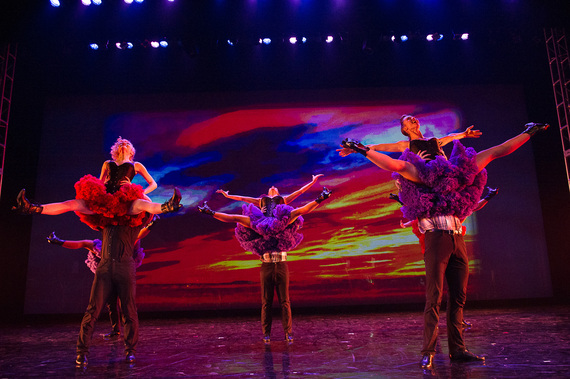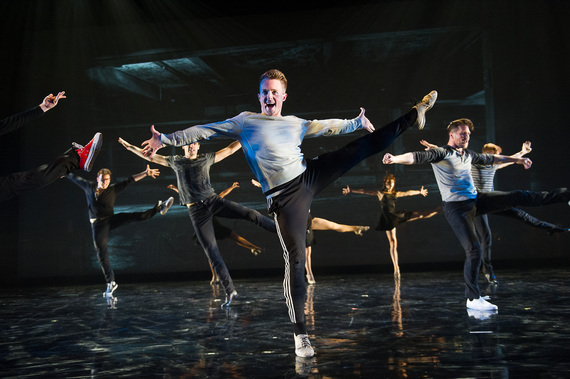The company of American Dance Machine for the 21st Century. Photo credit: Christopher Duggan.
Three weeks of rehearsals, 12 choreographers, 18 numbers, and 22 dancers: those were the statistics that culminated in American Dance Machine for the 21st Century's two-week stint at the Joyce Theater this winter. Directed by Wayne Cilento, the company's newest show covered everything from Tommy Tune to Agnes de Mille in a whirlwind of Broadway classics performed out of context except for screen projections establishing time and place.
"It definitely was a journey and hopefully an education without it being a stuffy education," Cilento said. "It's just a night of entertainment. And you walk away from that and you go, that's amazing choreographers."
From ballet to show-stopping tunes, Cilento wanted to prove that musical theater choreography can carry itself without the narrative and stamina of a two-act production. This, after all, was the intent of Lee Theodore when she founded ADM in 1976, and of current artistic director Nikki Feirt Atkins when she revived the organization in 2012.
By necessity, musical theater attracts some of the greatest talents in dance, who set original work on ensembles with the ability to survive the competitive worlds of Broadway and film. The staging and presentation become at least as critical to a show's success as its book and lyrics. But while the script is often preserved in hard copy at libraries and online through PDFs, the choreography can disappear almost as soon as the marquee goes dark. Therefore, ADM21 is devoted to serving as a near-archive for musical theater, curating and maintaining a collection of repertory from the Great White Way and the silver screen.
Jess LeProtto, Tyler Hanes, and Justin Prescott. Photo credit: Christopher Duggan.
This fall, Cilento was tasked with selecting ADM21's latest projects. His criteria were simple: the choreography must stand alone, worth protecting because of its own value.
Of course, he had plenty of options. Broadway alone has produced extraordinary work for a century, and all that ingenuity can't fit into one evening-length show. So, diplomatically, Cilento started with Jack Cole because "he's the father of jazz, everyone knows that." Cilento also wanted to reconstruct movie choreography, and searching through the maze that is YouTube, he finally landed on "Gotta Dance" from Singin' in the Rain. Then, he sprinkled in some Jerry Robbins and pieces from two of his own shows: Tony-winner The Who's Tommy and How to Succeed in Business Without Even Trying.
The bill continues with too many legends to list, and some newer voices, too. Mia Michaels rounded it out by offering a glance into what viewers can expect from tomorrow with "Calling You" from So You Think You Can Dance. Cilento said, "I feel that Mia is the up-and-coming wave that we're going to go through. I just felt that it was really important in this program to have the audience and the generation of today know where dance is going."
"There's no variety shows anymore, so you don't get that outlet for people to do amazing choreography," he continued. "So I think the fact that American Dance Machine is trying to do that, I think it's so needed and it's so worth doing. It's just a hard process."
That process includes recruiting stagers like Robert LaFosse to recreate steps and sequences, getting rights to music, and finding performers who are sufficiently adaptable to sing and dance with different techniques depending on what the number demands.
"A lot of the dancers today are very technically trained in the sense where it's pretty much competition and trick kind of choreography, so they're missing the education of the different styles," Cilento said.
Still, he was determined to find a capable ensemble that would function as just that: a troupe of unique but cohesive artists devoted to their craft. "One," the show's closing number from A Chorus Line (where Cilento coincidentally got his break) honors the rigor and hardships dancers must accept as part of their jobs. "You're a star, and then at some point in your career you have to go back to the ensemble if you want to keep working, until another job comes up that features you," he said.
Photo credit: Christopher Duggan.
As a former dancer, Cilento lent sympathy to his role as director, trying to give everyone their moment.
"I didn't want to bring in special guest artists," he explained. "I wanted the company to be versatile enough that they can have their moment, and I was really conscious of pulling out each individual so everyone had a feature."
In New York, ADM21 was met with enthusiasm. Times critic Alastair Macaulay called the troupe "an exceptional crew" of "vivid individuals" and thought it was "the best such anthology I've seen since 'Jerome Robbins' Broadway'" in 1989. Broadway World was more succinct: "This show was awesome!" wrote Caryn Cooper. And, after countless hours of research followed by a rushed rehearsal schedule, Cilento seemed pleased with how the dominoes fell.
"It was actually amazing," he said. "It really pulled together. Everyone did a great job. I think it went over really well."


